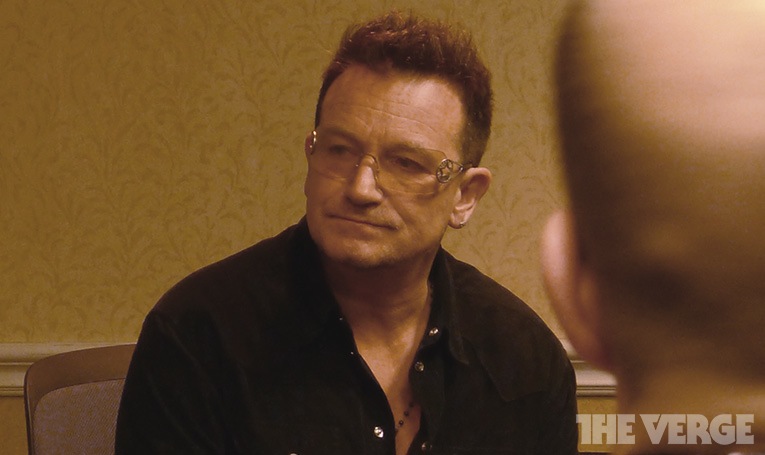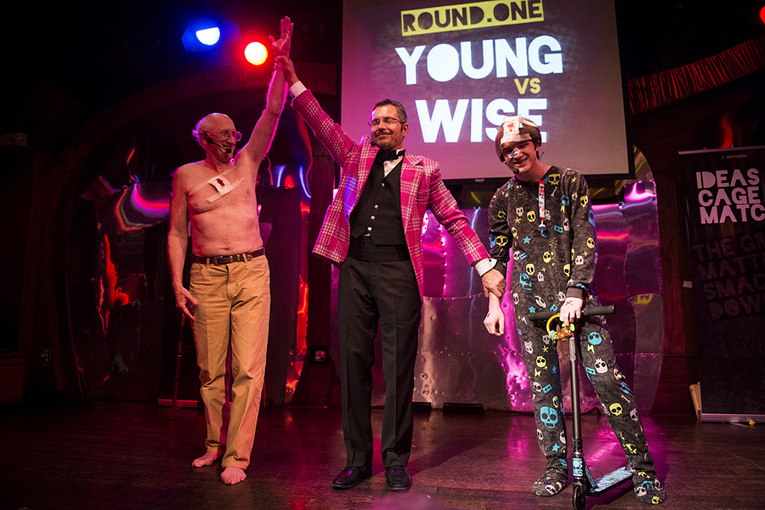Imagine, if you will, a snow globe. Wait, the snow globe is in California — Long Beach to be exact. It’s really sunny in this particular snow globe. There’s a beach. Okay, thinking of a west coast snow globe? Good.
What’s inside the snow globe? Buildings — say, the sprawling, mid-century Long Beach Convention Center, the Long Beach Arena, four hotels, maybe an aquarium down the road — streets, cars. A few Teslas even. People — lots of people. And of course snowflakes. The snowflakes (for our purposes) should represent ideas in this snow globe, and they rise and fall, are shaken up, vibrate if you will, in harmony with the people. From the people. People and ideas, vibrating, exchanging, walking, talking, eating — all together, all inside the snow globe. For a week. One week only.
That snow globe metaphor helped me to understand the TED conference (TED stands for Technology, Entertainment, and Design), a yearly happening focused on “ideas worth spreading.” Those ideas come in the form of 12 to 18 minute presentations (dubbed “TED talks”), which are later disseminated online.
Before I physically went to TED, my only real impression of what the event was like came to me through those short videos. A person on a stage, wearing a flesh colored headset, talking about a Big Idea. But it’s not just Big Ideas, or the people on stage. It’s temporary world unto itself that brings some of the smartest, weirdest, most powerful, and most famous people together in one place. To vibrate; to shake snowflakes. And this is what it’s like to be one of those people when it’s all shaking.
Making a snow globe from scratch
The anarchist and writer Hakim Bey described a Temporary Autonomous Zone (or T.A.Z.) as being "like an uprising which does not engage directly with the State, a guerrilla operation which liberates an area (of land, of time, of imagination) and then dissolves itself to re-form elsewhere/elsewhen, before the State can crush it." Bey argues that a T.A.Z. structure is that of a band structure, based on needs and preferences, not genetics or other rigid maps. "The band is open–not to everyone, of course, but to the affinity group, the initiates sworn to a bond of love. The band is not part of a larger hierarchy, but rather part of a horizontal pattern of custom, extended kinship, contract and alliance, spiritual affinities, etc."
Those two sentiments don’t describe TED in exact detail, but they come dangerously close. TED is a kind of T.A.Z.; a transitory experience that floats into Long Beach, assembles itself physically, psychologically, and spiritually, then decamps only to form again, in smaller pieces or in other places.
Anderson’s conference seems to point TEDsters in one main direction: an open and accepting exchange of IDEAS
In fact, it’s hard not to feel that Chris Anderson, the potentate and architect of TED in its gargantuan current form, isn’t working from a playbook littered with notes from Bey’s 1991 treatise.
But TED has structure Bey didn’t detail, and a form that is unmistakable and repeatable. And while Bey’s T.A.Z. imagined a more politically charged and dramatic basis for the gatherings, the engine that drives Anderson’s conference seems to point TEDsters in one main direction: an open and accepting exchange of ideas.
An open and accepting exchange of ideas with a religious fervor, that is.

Entering the globe
I arrived early at TED. Very early, days before the actual event would begin. Downtown Long Beach is a flat and relatively empty port town just south of Los Angeles. It reminded me of a Sim City, or a product of overfunded urban development with seemingly no plan for what was being developed. "Make a city here," you can imagine someone saying, with eyes closed as they put their finger down on a map. Let’s say Los Angeles and New York City are equally big and important cities. Being in Long Beach is like looking at Manhattan from the shores of New Jersey.
It is perfect for TED, and it's obvious after a week there why the TED team would have picked it. It feels isolated.
I had an opportunity to go inside the convention center while the skeleton of TED was exposed — the elaborate booths from Target and SyFy not fully built, the Steelcase furniture laid out in pieces on the floor, waiting for ratchet and screwdriver. I even toured the "media cave," where TED team members assemble and transmit the massive amount of video the company shoots during the five-day event. I am disappointed to say that it is not an actual cave, though since it’s in the basement of the convention center, it was dark and had very low ceilings. And delicious acai berry health shots.
Don’t want to hit the buffet? Just head down to the half-dozen food trucks out back
Once the skeleton had its guts and skin, TED immediately seemed larger than I expected. This was a conference with a capital C. Not quite CES, but a proper event with corporate sponsors, pop-up cafes, a "Moroccan" tent, an Intel / Vice chillout hub. Every room had several large refrigerators stocked with a cornucopian selection of still and sparkling beverages, Coca-Cola products, Odwalla smoothies. Free juices from Blueprint and Vitamin Water flowed like… water. There was pour-over coffee at every turn, 12 separate, recently brewed teas you could drink at any hour of the day, in six different locations. We were given bags with gifts like free $300 sunglasses, three-month movie theater passes, board games, a stuffed animal. Every day food was provided in abundance, delicious, healthy food prepared and restocked lovingly by attentive, friendly workers who crawled the indoor and outdoor buffets, always on the lookout for a depleted tray.
Don’t want to hit the buffet? Just head down to the half-dozen food trucks out back.
All of these pieces may seem superfluous or indulgent — and maybe they are on some basic level — but I came to understand that for better or worse, you couldn’t build the T.A.Z. of TED without these communal offerings. These wading pools, these enabler stations.
It was strange. It was surprising.
And it was just beginning.

Filling the globe
There are about 1500 people who attend the main TED conference, with hundreds more out in the deserts of Palm Springs at the companion TEDActive event (here’s contributor Trent Wolbe on his experience at Active). The conference feels full, but never packed.
The crowd is diverse, but not exactly the kind of diversity you think of when you hear the word. There are celebrities, CEOs, politicians, engineers, designers, scientists, philosophers, artists, even royalty. And while there are attendees from around the world, TED feels very white, for lack of a better way to describe it. This observation is not simply my own: it was communicated to me, unsolicited, by a number of other TEDsters during the conference. White in that specific way you can feel white people striving for diversity.
Various TED-attached or TED-related attendees can be found peppering the crowds. Some work with TED in an organizational or technical capacity, others are former speakers, TED Fellows (a kind of TED prep school), TEDx organizers, or TED hosts. And while it wasn’t immediately clear to me what some of those people did, what did become clear over the week I spent intermingling with the people at TED is that there is a subtle, unspoken strata that exists within the close-knit community.
There is a subtle, unspoken strata that exists within the close-knit community
TED is not flat, from a hierarchical standpoint. Though it strives to be flat — it wants to be a place where kings and peasants can exchange their equal currency of ideas — there are generational, economic, and societal incompatibilities amongst attendees that could be observed in subtle and not-so subtle ways. The longer you’re part of TED, the more pronounced those incompatibilities become. The most striking part of the disconnect was between that upper strata of speakers, former speakers, celebrities, and CEOs, and a surprisingly basic TED attendee who operated with a kind of business-like agenda. ‘What can I leave here with besides ideas,’ they seemed to be saying, hungrily scanning every room for their next hit. The gap between these A-list members and the schmooze- and party-hungry B-listers grew more obvious with each awkward encounter I witnessed, a business card being foisted into someone’s hand, a spongy stare as the big dog attendee tried to work their way out of an uncomfortable conversation.
New York Magazine quoted one attendee last year with a similar opinion. "There’s a very small cohort of smart people and CEOs—alphas—and a huge panoply of betas: senior vice-presidents. What’s fascinating is how many betas are in the room."
For a conference that has been repeatedly called elitist and exclusive, I was surprised at how, well, normal so many people seemed at TED.
TED normal, that is.

Shaking it up
The actual TED part of TED is really straightforward. Every day several sets of speakers are arranged into sessions — a thematic series of talks and performances usually lasting about two hours. ‘Secret Voices,’ ‘Coded Meaning,’ ‘The Spark,’ and so on. There are 12 sessions in all, with additional talks from TED Fellows, and TED U talks, which take place early in the day.
Some speakers are transcendent, illuminating, hilarious, or shocking. Some do nothing more than go up on stage and give a short presentation about the type of work they’re doing, have done, or will do. Others felt as if they were literally describing their job to you, with no punchline. Here’s what I do. Thank you.
And their job wasn’t particularly interesting.
This year’s talks touched on the economy, poverty, medicine, mental illness, the nature of art, bringing extinct animals back from the dead, robots, building better governments, and many, many other topics. I wouldn’t be lying if I told you that I watched a video of Peter Gabriel jamming with a gorilla who plays the piano. And yes, it blew my mind.
I wouldn’t be lying if I told you that I watched a video of Peter Gabriel jamming with a gorilla who plays the piano
TED honors its reputation by bringing an incredibly diverse group to its stage, but that also means amongst the obvious geniuses there are moments that seem to veer into quackery, and while the people brought up to stage are often questioned by Chris Anderson or his partner June Cohen, to describe those questions as "softballs" would be too forgiving.
One thing I was surprised to discover as a first time TEDster is that not all of the talks are really that stimulating. In fact, there were a number of talks that were either uninteresting, poorly executed, or just plain boring. Not surprisingly, TED doesn’t put every talk from these sessions online, so what most people think of as "TED caliber" is a heavily curated sampling of what you actually see at TED. Not everything everyone has to say on stage is edifying or even interesting. As of this writing, only four talks from TED 2013 have been posted on the group’s website.

Luckily for the schmooze-heavy show there is no requirement that you sit in the main auditorium during the talks. TED constructs little islands — lounges filled with bean bag chairs and snacks — where you can monitor the live stream.
TED intersperses the talks with entertainment. This year, there were performances from violinist Ji-Hae Park, "mouth-musician" Wang Li, the Sleepy Man Banjo Boys, and more.
What I found interesting is that by the standards of youth culture or pop culture, many of the performers wouldn’t seem as exciting or interesting to an average viewer as the population of TED made them out to be. Beardyman’s layering and manipulating of his own beatboxing, or the dance stylings of Rich + Tone Talauega may be exotic to TEDsters, but in the real world, they’re commonplace, or worse, passé. There was something of a cultural disconnect, TED at its worst, perhaps, when the largely white crowd watched the Afro-Cuban drummer Pedrito Martinez perform in session one, after Chris Anderson told us how TED had "discovered" him in a small New York restaurant. Martinez has been written about in the New York Times and has played on Grammy-winning albums. TED didn’t discover him so much as they discovered he existed.
When sessions aren’t happening, everyone empties out into the halls of the convention center or its massive concrete wraparound entrance and pathways. Outside, a heavy mingle happens. It happens all day, every day, with attendees circling and recircling, breaking off into little cliques, scoping out their next conversation, or sitting down in the sun to snack. It’s something like a college quad, but with old people. Well, older people. I had some of the most interesting and weirdest conversations during these periods — in some ways, I wish they had gone on longer, instead of just being short breaks between sessions.
To me, the value of TED was best expressed during those moments. When the ideas actually started spreading.

TEDiquette
Like all good Temporary Autonomous Zones, TED has its own rules and regulations, its own social norms, do's and don'ts, methods of communication, patterns of traffic. Some of the best and most crucial TED rules are born out of necessity, few seem to have been thoughtfully generated.
The first and most obvious tweak to behavior that I took note of in TEDsters was a change in gaze. You see, everyone at TED must wear their TED badge at all times; it is strictly enforced by the many security personnel stationed at the event. For people who’ve spent their life making eye contact, particularly with women — the badge hangs almost perfectly at cleavage level — this can be a jarring change. It’s not just that you begin to study the badges to learn a name or a company, either — attendees navigate into or out of conversations based on the data. More than once I watched fellow TEDsters duck their head down as they made their way towards a person of interest, only to change their mind in mid-flight (not interesting enough? not famous enough? thought they were someone else?), and veer away from the target, off to another conversation. I found myself checking out badges in more detail during conversations — wanting to make sure I had the full story on the TEDster I was talking to. And people checked mine out too. Journalists received badges with a black "PRESS" label slapped into the corner — a label I believe caused many people I spoke with to choose their words carefully. Or maybe I’m just paranoid.
Everyone at TED must wear their TED badge at all times
And that brings me to one of the best rules of TED: you can talk to anyone you want. It doesn’t matter who they are — you all basically have the same badge. (Except for press, what with our black mark). So, approaching Ben Affleck or Sergey Brin is totally fine no matter what. That doesn’t mean you’ll have a very comfortable conversation, but you’re welcome to try. I saw lots of tries. Lots of uncomfortable conversations.
TEDiquette demands your presence as much as possible. This is a conference where engagement is nearly mandatory. If you’re not in a session, you’d better be watching it somewhere. You will be graded on this.

Want to go out? You’re going out TED style. There are events planned throughout the evening; parties and performances at a variety of hotels. After hours TED "cage matches" where a shirtless Stewart Brand faces off against an adolescent wearing skull pajamas in a battle of wits (no, really). Amanda Palmer making the lobby of the Westin Long Beach bounce to a cover of The Clash’s "Should I Stay or Should I Go" while asking TED attendees hold their bean bags aloft, the crowd shaking the red blobs aggressively as she played.
Want to go out? You’re going out TED style
Drinks are poured, cultures are clashed. You don’t want to miss this.
TED doesn’t want you to leave. In fact, it needs you to stay. It needs you to stay because despite all of the sessions and the food and the chillout areas, it needs people more than anything to keep the T.A.Z. alive.
There are rules in the theater too. Don’t use your laptop, or you might miss something. Is someone using a laptop near you? Don’t be afraid to "give them the eye." Chris Anderson had to run the TED gang through best practices for standing ovations too. Don’t feel pressure to give a standing ovation, especially if it’s an emotional talk. If you want to give a standing ovation and no one else does, don’t be shy!
He’s right about the pressure though. This is the first note I took in my first session:
enormous pressure to clap
The fear of not loving a speaker enough is palpable. Not from the speakers, but from some ephemeral, ethereal, spiritual sense of community at TED — one that evokes weird guilt for not clapping hard enough or long enough. I don’t think this is TED itself, the organization. I think it’s what happens when lots of passionate and weird people get in a room together and listen to someone talking about escaping North Korea under fear of death. The claps are a kind of release from tension, a loud crash back into reality, an instinct many attendees seemed powerless against.

Cult of personality
"It’s like a cult," someone said to me. No, wait. Several people said that to me. It’s actually something I heard quite a bit from new attendees to the conference — and certainly something I thought more than once during my week at TED.
And it is like a cult; an atheist cult, an idea cult. But the rituals are vague, genuflection a social interaction and not a subjugation. There is an undeniable religious air to the thing, not just the rules and and the isolation, the exclusivity — but the tone of thinking, a pathological pressure to remain open-minded. If Judeo-Christian religions operate effectively by empirically answering questions and avoiding inquisition, TED works in the reverse, shunning the very concept of knowing — asking only that you bring an open mind. That your mind remains forever open, questioning. Questioning, but never quite judging.
The rituals are vague, genuflection a social interaction and not a subjugation
Part of that feeling is driven by the fact that there really isn’t debate at TED. Debate amongst attendees, late at night, over drinks, certainly — but even those debates feel guarded, protective of the speaker’s ideas. Scared to offend, the debater perhaps worried that they will be identified as closed minded, or that they’ll appear to have missed the point. Someone told me that at one point their "bullshit detector" went off. It was a journalist, you know, with the black label.
One of the more glaring demonstrations of this particular TED tweak came during session five on day two of the event. Chris Anderson invited Elon Musk to join him on stage for a kind of fireside chat, discussing the future of space travel, Earth travel, and probably most importantly, the future of renewable energy on the planet. Musk spoke passionately about the need for solar power use to rise to a plurality on the planet (equal to that of other sources, such as natural gas or oil). "If we don’t," he told Anderson, "we’re in a big trouble."
Musk, a wildly intelligent and successful businessman and inventor was followed by 18-year-old wunderkind Taylor Wilson. Wilson had been on the TED stage previously at the age of 14 to discuss the homemade fusion reactor he’d built. The TEDsters eat this kind of thing up.
Wilson touted the fact that he would not be going to college, instead opting to take his new company to market with a striking energy concept: smaller and safer nuclear fission reactors. His talk was littered with vague references to terrorism, and felt more than a little driven by a right-wing agenda. Just moments after Musk, a man who has been to college not once but twice, vigorously extolled our need for a clean, renewable source of energy on this planet, here’s an adolescent, uneducated, extremely junior nuclear "scientist" essentially shitting on his ideas.
Only at TED would two such divergent concepts (and people) be given equal time and weight. It’s a laudable quality of the talks, but frightening when you realize that the billionaires in the audience could be just as inclined to invest in smaller nuclear reactors as they might in solar.
There are other small controversies. This year, Eddie Huang, a member of TED’s Fellows program, was kicked out of the Fellows group (and TED altogether) for leaving the event to participate in a podcast in Los Angeles. Eddie — author of the recently published autobiography Fresh Off the Boat, owner of NYC restaurant Baohaus, and television host — is not the kind of guy who keeps quiet about these things. He took to Joe Rogan’s podcast following his dismissal and — you guessed it — basically called the Fellows program a cult.
"I just went through a whole week of people telling me what to do and where to be. It was like being at a fucking Scientology summer camp. It was horrible," he told Rogan. "I gave them four or five days of my time. Thirteen hours. Every day they have thirteen hours of fucking activities they have mapped out for you. Some days like fourteen or fifteen hours if you go to their after-hours events."
The commitment to be present at TED throughout all of the sessions and events is kind of astonishing
TED, on the other hand, saw it as a simple disagreement about the commitments Fellows make to the organization. Tom Rielly, head of the Fellows program, sent along this statement:
"When Eddie accepted the Fellowship … he also agreed to a stipulation that he would not arrive late to the conference nor leave early. Despite agreeing, Eddie Huang spent two days offsite during the conference without letting us know he’d be gone. So out of respect to the other fellows onsite and to the person who could have had his slot, we felt had no choice but to release him from the program. We wish him nothing but the best."
According to TED, 1200 people applied for the 20 Fellows slots, so they’re a little touchy about how seriously the chosen few take it. On the other hand, Eddie is right — the commitment to be present at TED throughout all of the sessions and events is kind of astonishing. You have to want to be there, really and truly. You have to commit to the T.A.Z.
TED doesn’t hold all of the attendees to quite the same standards as the Fellows, but the organizers certainly do everything they can to keep everyone inside the snow globe. Of course, almost everyone I spoke to who was attending TED wanted to be in the snow globe pretty badly.

Resonant vibrations
It would be easy to write TED off in the way many people have. To say TED is a cult, elitist, in love with itself and its own ideas — abstracted from what is real and true. To call it a playground for the rich, a place where they can pat each other on the back. To paint Chris Anderson in the role of messianic megalomaniac. To dismiss the positives because negatives exist. But I think that would be an inaccurate assessment, and ultimately unfair.
It would be easy to write TED off in the way many people have
TED is just a conference, after all; one with entry fees and free juice. But as a conference, it struck me as one of the more enriching and engaging ones. One of the more legitimately valuable conferences I’ve attended. Are parts imperfect? Yes. Cringe-worthy? Perhaps. Is it out of touch sometimes? How could it not be? Are TEDsters in love with themselves and their ideas? Definitely.
But most people at the conference also seemed to be in love with ideas, full stop; with the value of ideas, and the value of intellectual discourse and discovery. For all its rules and regulations, the religious over- or undertones, the isolationism and cultish devotion, there is one god that TED attendees seem to pray to, by and large: the God of Questions. And the God of Questions is the perfect and best god we could be praying to right now — when the problems we’re trying to solve can’t always be answered by old science or old math, by old religions or even old philosophers. By old ideas.
What better kind of Temporary Autonomous Zone — what more useful kind — can you think of than one built on new ideas?
I’m willing to let TED stumble a little while trying to ask those big questions. After all, there’s no such thing as a stupid question. Right?
Right?
Photo credits: TED, James Duncan Davidson, and Michael Brands
/cdn.vox-cdn.com/uploads/chorus_image/image/71360531/ted_lede1.1419979341.0.jpg)
Loading comments...